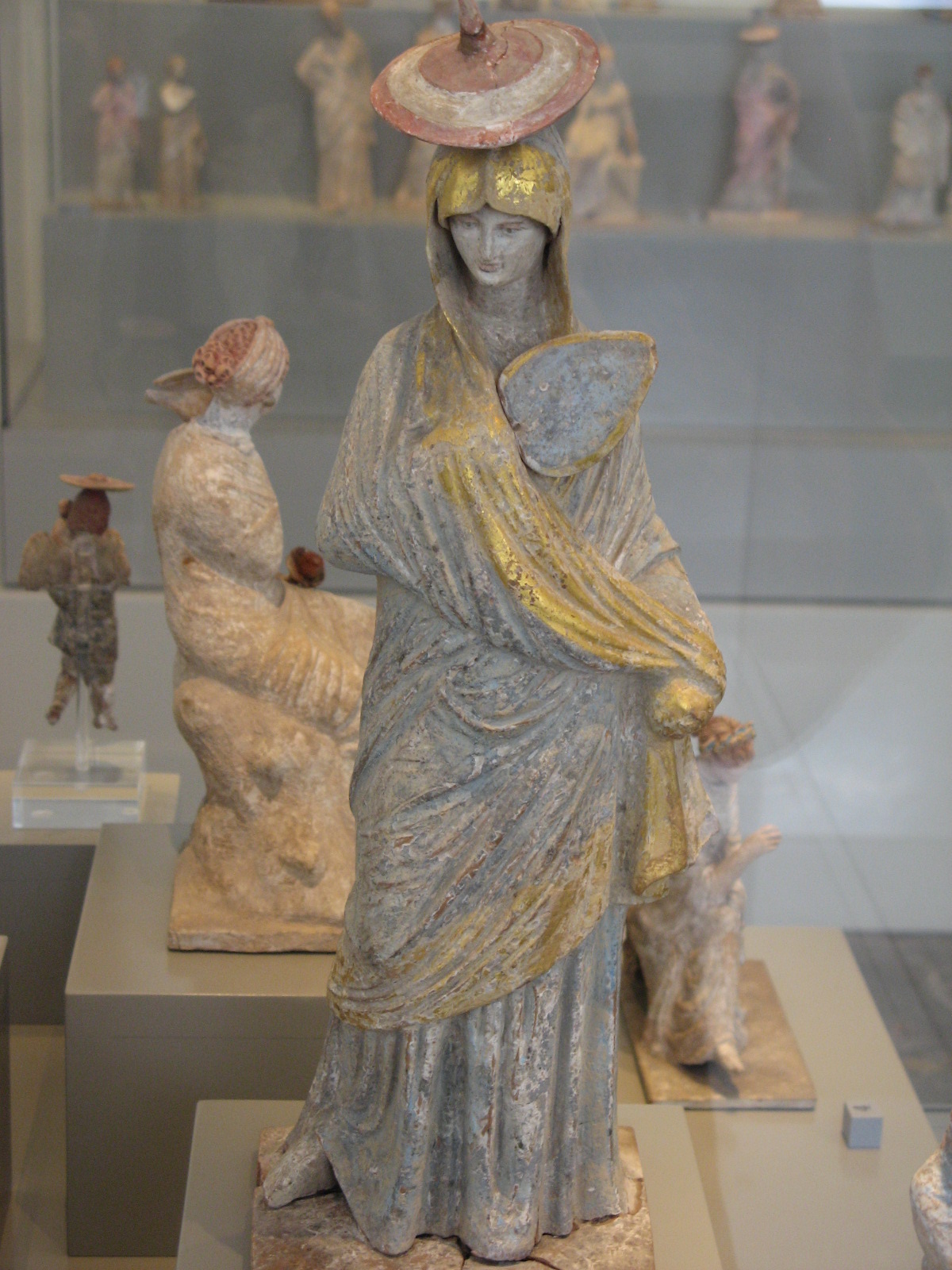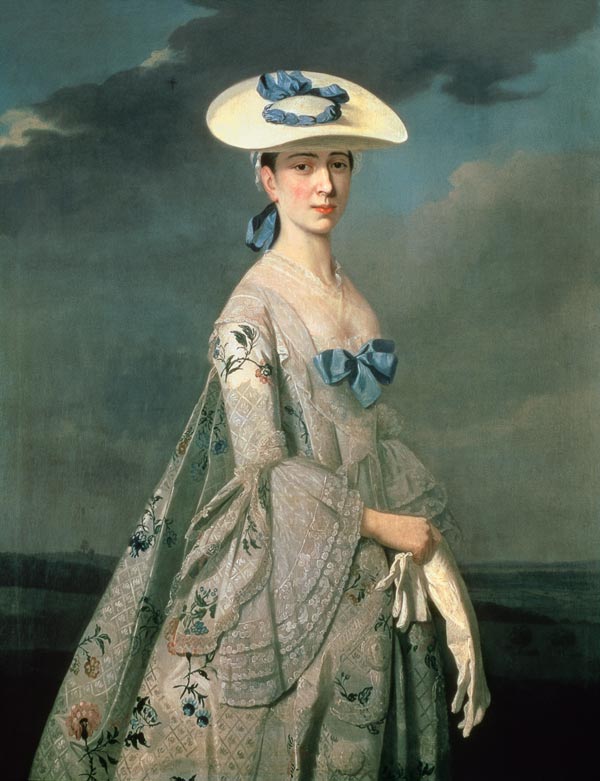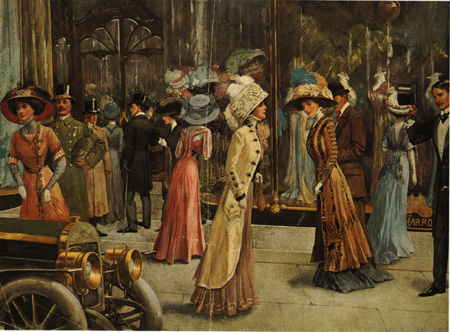It’s a ready assumption that hats have been around since,
well, heads have been around. We can
easily imagine those first human heads encountering sun, rain or cold and
searching for something – a leaf… an animal skin… a newspaper (OK, probably not
a newspaper) – to cover their head! Like
those of our ancient forebears, our modern heads sure appreciate a good
hat. And with our modern knowledge of
the sun’s rays, and the damage they can cause, we really value a good sun hat. Let’s take a look at how women’s sun
hats have evolved over the years, and where they’re at today.
 |
| Statue of an Ancient Greek Woman Wearing a Sun Hat via Wikimedia Commons (PD-Self) |
But in the 1700’s, it seems that hats began to come into
their own; fashion became on par with function.
The straw hat transitioned from lowly provincial garb to elegant
headgear worthy of a lady. In fact, for
centuries, the covering of women’s heads had been (and would continue to be) a
must, as dictated by moral standards. But
the demands of style were at work here as well; maintaining a milky complexion
was absolutely vital for the fashionable lady, so shielding the skin from the
sun was imperative.
 |
| Portrait of Eleanor Frances Dixie by Henry Pickering, circa 1753 via Wikimedia Commons (PD-Art) |
The shepherdess hat, the straw hat’s trendy new incarnation,
was worn throughout the 18th century. Also known as the bergère or milkmaid hat, it
had a small, short crown and a wide brim perfect for protecting the wearer’s
milky complexion. It was usually made of
straw and would have been adorned – simply or extravagantly - with some
combination of ribbons, flowers, and lace.
Fast forward to the beginning of the 19th
century, and the bonnet comes to fashion.
The bonnet’s shape was different, with the crown at the back of the
head, and the brim projecting forward to shade the face. The size of the brim grew and grew, until it
shielded the face not only from the sun, but from onlookers as well. For those craving extreme modesty, a veil
would have been added. Bonnets were
often constructed from straw and trimmed with ribbons. In the mid-1800’s, the parasol became de rigueur,
and the preferred means of shielding oneself from the sun. Consequently, bonnet brims receded, until the
bonnet was a small head covering with no brim at all. Indeed, hats in general grew upwards, rather
than outward, as the 19th century finished up.
Now in the early 20th century, the parasol is old
hat (so to speak), and the hat comes back in a big, big way. Hairstyles were big,
and hats were bigger… with brim size sometimes reaching beyond the shoulders. The embellishments were piled on – feathers,
ribbons, flowers, even whole, stuffed birds.
While these hats certainly weren’t letting any sunlight mar the
Edwardian lady’s complexion, they were so large that keeping them on was a
challenge. They were secured to the hair
with hat pins as long as 18 inches. 18
inches!
After the first World War broke out, hairstyles and hats
calmed down, becoming smaller and closer to the head. Fancy trimmings were considered unpatriotic; accordingly
hats became quite plain. Meanwhile,
flappers were emerging, bringing with them a brand new approach to
fashion. Accompanying the trend of a youthful,
boy-like silhouette came shorter hairstyles and the cloche hat. A cloche fit closely to the head, and had a
deep crown that came down low on the forehead. Some were brim-less, while others –
especially summer hats – had a brim that acted like a sun visor. While they were sometimes embellished, the
cloche’s look was quite streamlined compared to the Titanic hats from earlier in the century.
The 1930’s saw the return of fancy, as hats took on a
variety of shapes and plenty embellishment.
The shallow-crowned, wide brimmed hat – similar to the shepherdess hat –
made a resurgence, albeit with trimmings more appropriate for the day. As parasols were once again out of vogue, the
wide brims were appreciated as sun protection.
Throughout the 40’s and World War II, hats in every shape, size, and
decoration were seen. It’s worth noting
that until now there had been very little crossover between men’s and women’s
hats. The styles were vastly diverse,
the materials used were different, they were even made by different trades (a milliner
for women’s hats, a hatter for men’s). But now Men’s Fashions begin creeping into
Women’s looks, with military-inspired berets and the fedora becoming more
common ladies wear.
 |
| Hat-less women frolic on a beach in North Africa in 1944 via Wikimedia Commons (PD other reasons) |
At this point, we should bring up the suntan, and its
history. Until the 1900’s - for
centuries, perhaps millennia - sun-colored skin had been ardently avoided. It was the mark of lower class, who had to
work outside, exposed to the elements.
The quest for pale was so passionate that ladies would clothe themselves
from head to toe and carry a parasol. On top of that, in some eras, there was prevalent
use of lead-based skin lighteners. Talk
about making sacrifices for beauty!
As the 20th century commenced, these age-old attitudes
toward the sun began a major transition.
First, doctors started to learn of benefits that the sun can provide,
for example, sunlight was used as a remedy for rickets. So, exposure to sunlight begins earning a new
reputation. Then, in 1923, Coco Chanel
made the historic move of getting a suntan and boasting about it. Sunbathing was born, and a sun-kissed “glow” became
the ambition of all. Though hats were
still very much in vogue at that point, as the decades passed, they became less
compulsory. The newborn desire for
tanned skin, the acceptance of sunlight as a medical treatment, and a waning
emphasis on modesty meant that the wearing of hats was now optional. After World War II, it was common for ladies
to leave the house without a hat, and by the 1960’s, wearing of hats was mostly
old-fashioned.
The absence of hats in fashion (with some exceptions) has
been the norm until recent years, when the risks of tanning were
uncovered. It was determined that
exposure to the sun’s UVA and UVB rays contributed to skin cancers as well as
wrinkles and premature aging. The advice
of medical experts to avoid sunburns and suntans has spurred a new appreciation
for sun hats.
 |
| Fashionable Sun Hat: Pitch Perfect in black/natural tweed From SolEscapes.com |
We have come full circle.
The sun hat has been re-born, and beautifully so! Today’s sun hats reflect the past, echoing
styles such as the straw hat, the cloche and the fedora. At the same time, they’re modern,
complementing today’s trends. Current
sun hats are not likely to be festooned with voluminous layers of feathers, but
do carry on-trend embellishments such as metallic threads, gorgeous colors and sophisticated
ribbons. There is such a range of
styles, that there is something for everyone and every activity. Glamorous wide brimmed hats
are well suited for a day lounging at the resort pool, while sporty visors look
great for a round of golf. A bucket hat
is perfect for a play day at the beach, and a straw
sun hat makes working in the rose garden safe and enjoyable.
Not to be outdone by their good looks, these modern-day hats
are hard working too. The materials are
crafted to provide ultimate sun protection; many hats have a UPF 50+ rating,
meaning they block 98% of the sun’s ultraviolet rays. The large brims on sun hats give even more
coverage, providing good shade for the head and face. Features such as adjustable head size make
the hats comfortable; a pleasure to wear.
Even more, many sun hats can be folded or rolled, so they’re easy to
pack for a trip to the beach, resort vacation, or island cruise getaway.
Sun hats have a rich history, including a recent,
regrettable decline. How fortunate that
sun hats are back - and we dare say - here to stay. They perform the crucial role of shading us
from the sun, keeping us safe and comfortable.
Just as (or more?) importantly, they act as stunning accessories,
complementing wardrobes, heightening style and adding flare to our fun,
sun-filled lives.
What historical sun hat would you love to wear?
 |
| Sporty Naples Visor / Sun Hat Combo from SolEscapes.com |
 |
| Pretty Bimini Ribbon Sun Hat from SolEscapes.com |
Sources: The Spokesman, Vintage Fashion Guild, House of Nines Design, The Dreamstress, Recollections Blog, The Guardian, Skin Cancer Foundation











